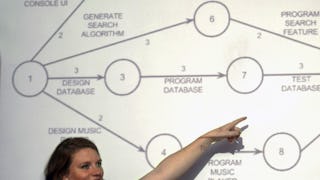Filter by
SubjectRequired
LanguageRequired
The language used throughout the course, in both instruction and assessments.
Learning ProductRequired
LevelRequired
DurationRequired
SkillsRequired
SubtitlesRequired
EducatorRequired
Explore the UML Diagram Course Catalog

University of Michigan
Skills you'll gain: Application Deployment, Django (Web Framework), Object-Relational Mapping, HTML and CSS, Model View Controller, jQuery, Ajax, Hypertext Markup Language (HTML), JSON, SQL, Databases, Application Development, Javascript, Object Oriented Programming (OOP), Web Development, Back-End Web Development, Data Modeling, Application Security, Web Applications, Web Servers

University of Alberta
Skills you'll gain: Sprint Planning, Project Risk Management, Risk Management, User Story, Backlogs, Agile Methodology, User Requirements Documents, Functional Requirement, Agile Project Management, Requirements Analysis

Illinois Tech
Skills you'll gain: Database Design, Relational Databases, Database Theory, Data Modeling, Unified Modeling Language, Database Architecture and Administration, Databases, Data Integrity, Functional Requirement, Conceptual Design, Requirements Analysis

University of Colorado System
Skills you'll gain: Unified Modeling Language, Unit Testing, Software Design, Software Engineering, Software Development Tools, JUnit, Software Testing, Design, Development Testing, Data Ethics, Test Tools, Software Architecture, Dataflow, Conceptual Design

Coursera Project Network
Skills you'll gain: Data Import/Export, Technical Communication, Technical Documentation, Graphical Tools, User Accounts

Skills you'll gain: Data Storytelling, Business Metrics, Key Performance Indicators (KPIs), Data Cleansing, Data Modeling, Analytics, Data Analysis, Data Visualization, Data Validation, Exploratory Data Analysis, Data Quality, Data Manipulation, Generative AI, Data Collection

Coursera Project Network
Skills you'll gain: Computer-Aided Design, AutoCAD, Design Software, Drafting and Engineering Design, Product Design, Technical Drawing

Coursera Project Network
Skills you'll gain: ChatGPT, Unified Modeling Language, OpenAI, Generative AI, Software Visualization, Artificial Intelligence, Software Design Documents, Technical Communication, User Story, Application Programming Interface (API), Software Development Tools, Natural Language Processing, Development Environment, Software Development

University of Illinois Urbana-Champaign
Skills you'll gain: 3D Modeling, Design Software, Conceptual Design, Visualization (Computer Graphics), Computer Graphics, Design, Digital Design, Graphic and Visual Design Software, Computer Vision
 Status: Free
Status: FreeNational Taiwan University
Skills you'll gain: Autodesk Revit, Building Information Modeling, Autodesk, AutoCAD, Construction Estimating, Simulation and Simulation Software, 3D Modeling, Construction Management, Cost Estimation

Arizona State University
Skills you'll gain: Mechanical Engineering, Thermal Management, Engineering, Engineering Analysis, Process Control, Process Analysis

University of Colorado System
Skills you'll gain: Database Design, Software Design, Usability Testing, User Interface and User Experience (UI/UX) Design, Databases, Software Architecture, Software Design Patterns, Systems Design, Application Security, Design Strategies, Operating Systems
UML Diagram learners also search
In summary, here are 10 of our most popular uml diagram courses
- Django for Everybody: University of Michigan
- Agile Planning for Software Products: University of Alberta
- Relational Database Design: Illinois Tech
- Software Design Methods and Tools: University of Colorado System
- Create IT Diagrams with Lucidchart: Coursera Project Network
- Introduction to Data Analytics: Meta
- Product Development using AutoCAD: Coursera Project Network
- OpenAI Assistant: Create a Code to UML-Diagram generator: Coursera Project Network
- 3D Printing Software: University of Illinois Urbana-Champaign
- BIM Application for Engineers: National Taiwan University










